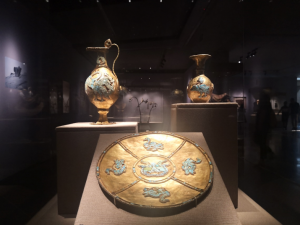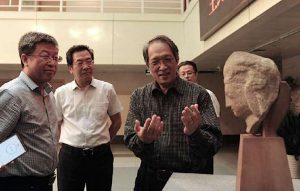
The revered Korean Dharma master and social activist Venerable Pomnyun Sunim recently led a cohort of 430 Buddhist practitioners on Jungto Society’s 34th annual pilgrimage across India and to Nepal, following in the footsteps of the historical Buddha to visit key sites connected with his life, spiritual practice, enlightenment, and Dharma teachings.
Jungto Society is a volunteer-run international Buddhist community that aspires to embody the Buddhist teachings through social engagement, and by promoting a simple lifestyle centered on sustainable living. The community seeks to address the crises of modern society, such as greed, poverty, conflict, and environmental degradation, by applying a Buddhist worldview of interconnectedness and living in line with the principle that everyone can find happiness through Buddhist practice and active participation in social movements.
“Although we call it a pilgrimage because we’re visiting sacred places, from a Buddhist perspective, it’s not accurate to say that there are particularly sacred lands or especially sacred days. This is because the Buddhist teaching is that all phenomena are empty,” Ven. Pomnyun Sunim explained during his Dharma talk for the opening ceremony on the first day of the pilgrimage.
“A pilgrimage is about following in the footsteps of Shakyamuni Buddha, our great teacher whom we respect most and consider our role model. Studying the Buddha’s footsteps through books and videos . . . can be somewhat abstract, limited to memorizing or understanding with our minds. The reason for pilgrimage is to learn vividly how the Buddha actually responded to many problems in this world during his time, and how he guided people who were suffering and in anguish to find their way out of suffering.” (Jungto Society)
Running from 11–23 January, the pilgrimage began in Sarnath, near Varanasi, where the Buddha gave his first Dharma teaching after attaining liberation beneath the Bodhi tree. The pilgrims found refuge at Buddhist temples en route,
Seated before the Dhamek Stupa in the Deer Park, the site of the Buddha’s first Dharma sharing, the 430 pilgrims were formally ordained as renunciates for the duration of the pilgrimage, clad in a symbolic monastic robe and bearing alms bowl, the practitioners took a solemn vow to uphold the precepts, repenting for past wrongs and preparing themselves for their spiritual commitment in the days ahead.
The pilgrims then visited the hilltop site of Gayasisa, where the Buddha taught his Fire Sermon, before traveling to Sujata Academy in Dungeshwari, a school, health clinic, and community center that Ven. Pomnyun Sunim established more than 30 years ago to help the local communities of Dalit villagers to lift their lives out of hunger, illiteracy, and disease.
The practitioners visited the nearby Pragbodhi Hills where Siddhartha Gautama practiced austerities for six years after renouncing his former life as a prince. Then it was on to Bodh Gaya, where Siddhartha would become the Buddha. En route, the pilgrims visited the site of Sujata’s offering of nourishment to the ailing Buddha, before arriving at the Mahabodhi Temple, where Ven. Pomnyun Sunim offered a Dharma teaching for the pilgrims beneath the sacred Bodhi tree.
“The most important teachings of Buddhism are the law of dependent origination and the Middle Way,” Ven. Pomnyun Sunim explained. “The Buddha discovered the Middle Way at Pragbodhi Hill and realized the law of dependent origination here in Bodh Gaya where we are now sitting. Terms such as ‘buddha,’ ‘liberation,’ ‘nirvana,’ and ‘samsara’ were originally used in India. The difference lies in the interpretation of these terms in Indian tradition compared with Buddhism. However, the Middle Way and the law of dependent origination are unique to Buddhism and cannot be found in traditional Indian thought. This uniqueness of Buddhism originated here in the Bodh Gaya area.”
The monk continued: “Here, the Buddha discovered that neither the traditional pursuit of happiness through hedonism nor the newly emerging asceticism proposed by new thinkers was the true path to liberation. The only path to liberation was the Middle Way, which does not lean toward either extreme. Following desires and suppressing desires are both merely reactions to desire. The third path that the Buddha discovered is not between these two paths, but a new path that abandons both. It involves merely being aware of desire without following nor rejecting it. Not reacting to desire is the true way to become free from desire . . .
“The content of the Buddha’s enlightenment is, first, the law of dependent origination. The Buddha spoke of dependent origination like this:
‘When this exists, that comes to be; with the arising of this, that arises. When this does not exist, that does not come to be; with the cessation of this, that ceases.’”
“A more detailed expression of this law of dependent origination is the 12 links of dependent origination,” Ven. Pomnyun Sunim noted. “The 12 links explain the process of tracing back the cause of causes. Spatial dependent origination became the teaching of ‘non-self,’ indicating the lack of inherent existence, while temporal dependent origination became the teaching of ‘impermanence’ from the perspective of cause and effect and change.
“Thus, the law of dependent origination is impermanence and non-self. When one knows the law of dependent origination, all suffering disappears; when one doesn’t know it, one can only suffer. When one knows impermanence and non-self, one attains nirvana; when one doesn’t know impermanence and non-self, everything becomes suffering. These are called the Three Marks of Existence. This is the most essential content of what the Buddha realized. The Four Noble Truths are the application of this to help the masses realize it. Recognizing the reality of suffering (the truth of suffering), investigating its cause (the truth of the origin of suffering), realizing that when the cause is extinguished, one reaches a state free from suffering (the truth of the cessation of suffering), and maintaining eight kinds of awareness to prevent the recurrence of suffering (the truth of the path). These are the Four Noble Truths and the Noble Eightfold Path. Thus, the Buddha’s teachings are structured in a very simple system. It was later scholars who made the Buddha’s teachings more complicated.” (Jungto Society)
From Gaya, the pilgrims forged onward to Rajgir, the capital of the Magadha kingdom during Buddha’s time, visiting several significant Buddhist sites: Jethian, the path where King Bimbisara of Magadha greeted the Buddha; Vulture Peak, renowned as the site where the Lotus Sutra was preached; Venuvana, in Rajagriha, the first Buddhist monastery; and Saptaparni Cave, where the First Buddhist Council was held after Buddha’s mahaparinirvana.
The pilgrimage proceeded to Vaishali, home to the original Relic Stupa enshrining Buddha’s relics, and also known as the place where the Buddha first allowed women to become monastics. This was followed Kushinagar, home to the Kesaria Stupa built by the Mauryan emperor Ashoka, Cunda’s offering site, and the Kakuttha River, before paying homage at the Mahaparinirvana Temple and Ramabhar Stupa.
The practitioners then moved onward to visit sacred sites in Nepal: the Ramagram relic stupa, the Rohini River, and Lumbini, the birthplace of the Buddha, before returning to India to continue their pilgrimage in Sravasti, Jetavana, and Sankissa.
“After attaining enlightenment, the Buddha spent his entire life trying to save suffering beings, but the number of beings he saved is only as much as a single leaf. The remaining beings are as numerous as the leaves in a forest. We should have the mindset of saving the rest of those leaves. If we approach with this attitude, this world will become brighter,” Ven. Pomnyun Sunim told the pilgrims.
“However, there are still countless people in this world who have not yet formed a connection with the Dharma. So, starting from our surroundings and extending to the whole world, we must widely spread this wonderful teaching to help many people live freely and without suffering. It is with this aspiration that we engage in Dharma propagation activities. We should practice diligently to become people free from suffering, and then transmit this teaching to those around us so that they too can become free from suffering. This is called ‘seeking enlightenment above and saving sentient beings below.’ In other words, we are called ‘bodhisattvas,’ beings who strive for enlightenment while helping others.
“This is why Mahayana Buddhism forms its sangha with bodhisattvas. The fourfold assembly includes not only ordained male and female monastics but also male and female lay practitioners, and together they form the sangha. The sangha is not composed of believers, but of practitioners. Jungto Society conducts pilgrimages with this orientation. That’s why you have come on this pilgrimage to become practitioners yourselves.” (Jungto Society)

Ven. Pomnyun Sunim is a widely revered Korean Dharma teacher, author, and social activist. He has founded numerous organizations, initiatives, and projects across the world, among them: JTS Korea, an international humanitarian relief organization working to eradicate poverty and hunger; Jungto Society, a volunteer-based community founded on the Buddha’s teachings and dedicated to addressing modern social issues that lead to suffering; EcoBuddha, an organization focused on environmental ethics and sustainable living based on the teachings of the Buddha; and Good Friends, which promotes reconciliation and cooperation between the North and South Korea, and provides humanitarian aid to North Koreans. Ven. Pomnyun Sunim is also patron of the International Network of Engaged Buddhists (INEB).
In October 2020, the Niwano Peace Foundation in Japan presented the 37th Niwano Peace Prize to Ven. Pomnyun Sunim in recognition of his international humanitarian work, intensive environmental and social activism, and his tireless efforts to build trust and goodwill between communities of different faiths and cultures, toward the goal of world peace.*
* Buddhist Monk Ven. Pomnyun Sunim Awarded the 37th Niwano Peace Prize (BDG)
See more
Pomnyun
Jungto Society
Jungto
Jungto Dharma School (Jungto)
International Network of Engaged Buddhists (INEB)
Related news reports from BDG
Online Dharma: Jungto Society Announces 2025 Intake for Jungto Dharma School with Ven. Pomnyun Sunim
Special Report: Footsteps of the Buddha – Ven. Pomnyun Sunim Leads 500 Practitioners on the 33rd Jungto Pilgrimage across India and Nepal
Engaged Buddhism: Ven. Pomnyun Sunim and JTS Volunteers Visit Sujata Academy Project in India
Related features from BDG
In the Footsteps of the Buddha: Ven. Pomnyun Sunim Leads 1,250 Jungto Practitioners on a Pilgrimage to India
Special Report: The Hope of the World – Ven. Pomnyun Sunim Marks the 30th Anniversary of the Sujata Academy Project in India
Sujata Academy: The Power of Hope and Compassion in India
The Hungry Should Eat: JTS Brings Buddhist Compassion and Relief to India
























